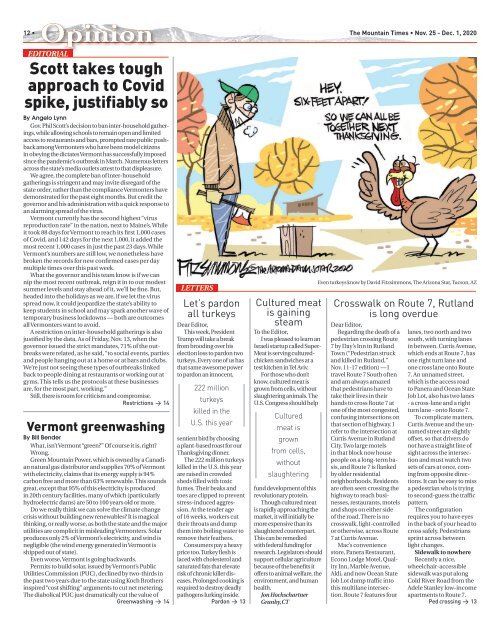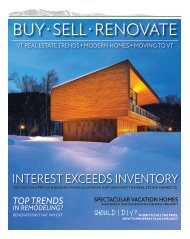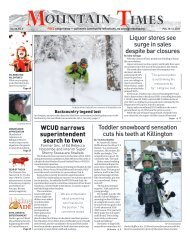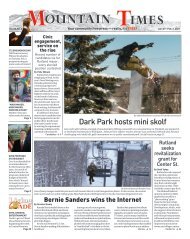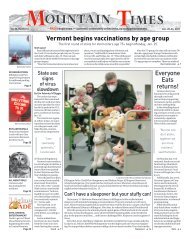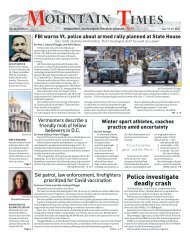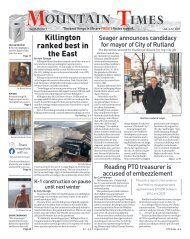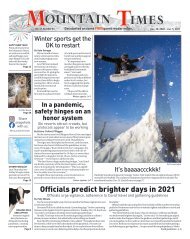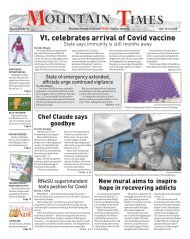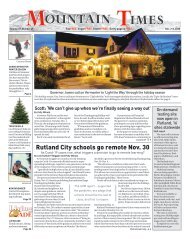Mountain Times - Volume 49, Number 48 - Nov. 25- Dec. 2, 2020
You also want an ePaper? Increase the reach of your titles
YUMPU automatically turns print PDFs into web optimized ePapers that Google loves.
Opinion<br />
12 • The <strong>Mountain</strong> <strong>Times</strong> • <strong>Nov</strong>. <strong>25</strong> - <strong>Dec</strong>. 1, <strong>2020</strong><br />
EDITORIAL<br />
Scott takes tough<br />
approach to Covid<br />
spike, justifiably so<br />
By Angelo Lynn<br />
Gov. Phil Scott’s decision to ban inter-household gatherings,<br />
while allowing schools to remain open and limited<br />
access to restaurants and bars, prompted rare public pushback<br />
among Vermonters who have been model citizens<br />
in obeying the dictates Vermont has successfully imposed<br />
since the pandemic’s outbreak in March. Numerous letters<br />
across the state’s media outlets attest to that displeasure.<br />
We agree, the complete ban of inter-household<br />
gatherings is stringent and may invite disregard of the<br />
state order, rather than the compliance Vermonters have<br />
demonstrated for the past eight months. But credit the<br />
governor and his administration with a quick response to<br />
an alarming spread of the virus.<br />
Vermont currently has the second highest “virus<br />
reproduction rate” in the nation, next to Maine’s. While<br />
it took 88 days for Vermont to reach its first 1,000 cases<br />
of Covid, and 142 days for the next 1,000, it added the<br />
most recent 1,000 cases in just the past 23 days. While<br />
Vermont’s numbers are still low, we nonetheless have<br />
broken the records for new confirmed cases per day<br />
multiple times over this past week.<br />
What the governor and his team know is if we can<br />
nip the most recent outbreak, reign it in to our modest<br />
summer levels and stay ahead of it, we’ll be fine. But,<br />
headed into the holidays as we are, if we let the virus<br />
spread now, it could jeopardize the state’s ability to<br />
keep students in school and may spark another wave of<br />
temporary business lockdowns — both are outcomes<br />
all Vermonters want to avoid.<br />
A restriction on inter-household gatherings is also<br />
justified by the data. As of Friday, <strong>Nov</strong>. 13, when the<br />
governor issued the strict mandates, 71% of the outbreaks<br />
were related, as he said, “to social events, parties<br />
and people hanging out at a home or at bars and clubs.<br />
We’re just not seeing these types of outbreaks linked<br />
back to people dining at restaurants or working out at<br />
gyms. This tells us the protocols at these businesses<br />
are, for the most part, working.”<br />
Still, there is room for criticism and compromise.<br />
Restrictions > 14<br />
Vermont greenwashing<br />
By Bill Bender<br />
What, isn’t Vermont “green?” Of course it is, right?<br />
Wrong.<br />
Green <strong>Mountain</strong> Power, which is owned by a Canadian<br />
natural gas distributor and supplies 70% of Vermont<br />
with electricity, claims that its energy supply is 94%<br />
carbon free and more than 63% renewable. This sounds<br />
great, except that 95% of this electricity is produced<br />
in 20th century facilities, many of which (particularly<br />
hydroelectric dams) are 50 to 100 years old or more.<br />
Do we really think we can solve the climate change<br />
crisis without building new renewables? It is magical<br />
thinking, or really worse, as both the state and the major<br />
utilities are complicit in misleading Vermonters. Solar<br />
produces only 2% of Vermont’s electricity, and wind is<br />
negligible (the wind energy generated in Vermont is<br />
shipped out of state).<br />
Even worse, Vermont is going backwards.<br />
Permits to build solar, issued by Vermont’s Public<br />
Utilities Commission (PUC), declined by two-thirds in<br />
the past two years due to the state using Koch Brothers<br />
inspired “cost shifting” arguments to cut net metering.<br />
The diabolical PUC just dramatically cut the value of<br />
Greenwashing > 14<br />
LETTERS<br />
Let’s pardon<br />
all turkeys<br />
Dear Editor,<br />
This week, President<br />
Trump will take a break<br />
from brooding over his<br />
election loss to pardon two<br />
turkeys. Every one of us has<br />
that same awesome power<br />
to pardon an innocent,<br />
222 million<br />
turkeys<br />
killed in the<br />
U.S. this year<br />
sentient bird by choosing<br />
a plant-based roast for our<br />
Thanksgiving dinner.<br />
The 222 million turkeys<br />
killed in the U.S. this year<br />
are raised in crowded<br />
sheds filled with toxic<br />
fumes. Their beaks and<br />
toes are clipped to prevent<br />
stress-induced aggression.<br />
At the tender age<br />
of 16 weeks, workers cut<br />
their throats and dump<br />
them into boiling water to<br />
remove their feathers.<br />
Consumers pay a heavy<br />
price too. Turkey flesh is<br />
laced with cholesterol and<br />
saturated fats that elevate<br />
risk of chronic killer diseases.<br />
Prolonged cooking is<br />
required to destroy deadly<br />
pathogens lurking inside.<br />
Pardon > 13<br />
Cultured meat<br />
is gaining<br />
steam<br />
To the Editor,<br />
I was pleased to learn an<br />
Israeli startup called Super-<br />
Meat is serving culturedchicken<br />
sandwiches at a<br />
test kitchen in Tel Aviv.<br />
For those who don’t<br />
know, cultured meat is<br />
grown from cells, without<br />
slaughtering animals. The<br />
U.S. Congress should help<br />
Cultured<br />
meat is<br />
grown<br />
from cells,<br />
without<br />
slaughtering<br />
fund development of this<br />
revolutionary protein.<br />
Though cultured meat<br />
is rapidly approaching the<br />
market, it will initially be<br />
more expensive than its<br />
slaughtered counterpart.<br />
This can be remedied<br />
with federal funding for<br />
research. Legislators should<br />
support cellular agriculture<br />
because of the benefits it<br />
offers to animal welfare, the<br />
environment, and human<br />
health.<br />
Jon Hochschartner<br />
Granby, CT<br />
Even turkeys know by David Fitzsimmons, The Arizona Star, Tucson, AZ<br />
Crosswalk on Route 7, Rutland<br />
is long overdue<br />
Dear Editor,<br />
Regarding the death of a<br />
pedestrian crossing Route<br />
7 by Day’s Inn in Rutland<br />
Town (“Pedestrian struck<br />
and killed in Rutland,”<br />
<strong>Nov</strong>. 11-17 edition) — I<br />
travel Route 7 South often<br />
and am always amazed<br />
that pedestrians have to<br />
take their lives in their<br />
hands to cross Route 7 at<br />
one of the most congested,<br />
confusing intersections on<br />
that section of highway. I<br />
refer to the intersection at<br />
Curtis Avenue in Rutland<br />
City. Two large motels<br />
in that block now house<br />
people on a long-term basis,<br />
and Route 7 is flanked<br />
by older residential<br />
neighborhoods. Residents<br />
are often seen crossing the<br />
highway to reach businesses,<br />
restaurants, motels<br />
and shops on either side<br />
of the road. There is no<br />
crosswalk, light-controlled<br />
or otherwise, across Route<br />
7 at Curtis Avenue.<br />
Mac’s convenience<br />
store, Panera Restaurant,<br />
Econo Lodge Motel, Quality<br />
Inn, Marble Avenue,<br />
Aldi, and now Ocean State<br />
Job Lot dump traffic into<br />
this multilane intersection.<br />
Route 7 features four<br />
lanes, two north and two<br />
south, with turning lanes<br />
in between. Curtis Avenue,<br />
which ends at Route 7, has<br />
one right turn lane and<br />
one cross lane onto Route<br />
7. An unnamed street,<br />
which is the access road<br />
to Panera and Ocean State<br />
Job Lot, also has two lanes<br />
- a cross-lane and a right<br />
turn lane - onto Route 7.<br />
To complicate matters,<br />
Curtis Avenue and the unnamed<br />
street are slightly<br />
offset, so that drivers do<br />
not have a straight line of<br />
sight across the intersection<br />
and must watch two<br />
sets of cars at once, coming<br />
from opposite directions.<br />
It can be easy to miss<br />
a pedestrian who is trying<br />
to second-guess the traffic<br />
pattern.<br />
The configuration<br />
requires you to have eyes<br />
in the back of your head to<br />
cross safely. Pedestrians<br />
sprint across between<br />
light changes.<br />
Sidewalk to nowhere<br />
Recently a nice,<br />
wheelchair-accessible<br />
sidewalk was put along<br />
Cold River Road from the<br />
Adele Stanley low-income<br />
apartments to Route 7.<br />
Ped crossing > 13


